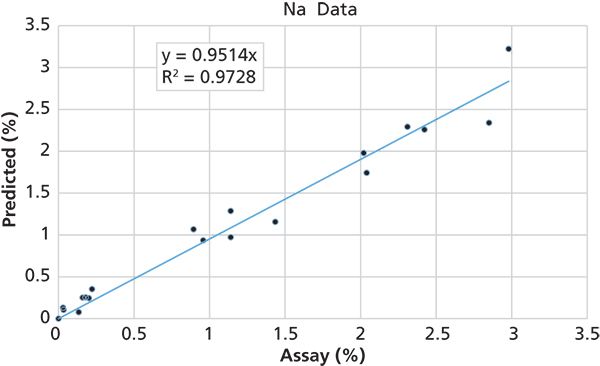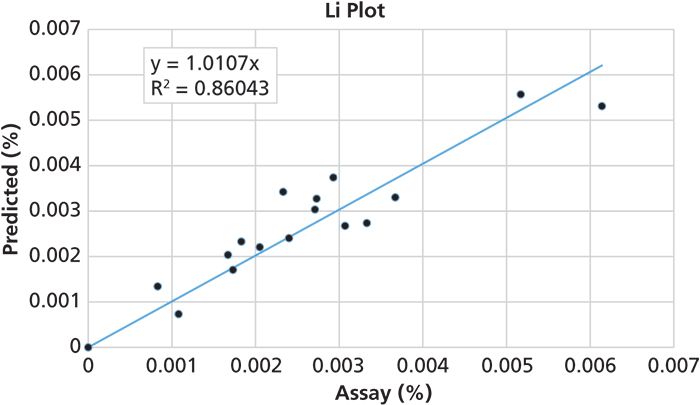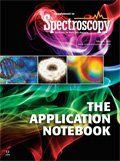In-Field Measurements of Major Elements and Base Metals with Handheld LIBS
Application Notebook
The Z-500 also analyzes base metals and trade elements, including Mg, Ti, V, Cr, Fe, Mn, Cu, Ni, and others. Trace metals of commercial interest or as pathfinders including Li, Be, B, C, and halogens including F, Cl, and Br are also analyzed. Figure 2 shows results for Li analysis, as an example. The results for lithium analysis were reasonably good. While there is some scatter in the data, the HH LIBS is measuring very low concentrations, in the 10–30 ppm concentration range. In general, the results for B, Be, Mg, Ba, and other elements were comparable, in terms of correlation, with the Li data.
Data for a handheld LIBS device (SciAps Z-500) is presented demonstrating in-field measurement of several elements critical for geochemical applications. In some cases these elements have never before been measured with a handheld device.
A new handheld laser induced breakdown spectroscopy (LIBS) analyzer has been introduced for elemental analysis of geochemical samples. The SciAps Z-series handheld LIBZ analyzers feature a pulsed, 5–6 mJ laser, 1064 nm Class 3 laser and high resolution spectrometer spanning the wavelength range 190 nm out to 860 nm (with optional coverage to 930 nm).
The Z also includes an integrated, replaceable argon purge. LIBS analysis in the presence of argon yields greatly improved precision and as much as 10× lower limits of detection compared to air-based laser analysis. The spectrometer's wavelength coverage offers analysis of virtually any element in the periodic table, including several elements that could never before be analyzed in the field with a handheld device: sodium, lithium, boron, beryllium, carbon, and fluorine.

Major Element Geochemistry and Geochemical Indices
For mineral and ore applications, the critical elements are Na, Ca, K, Al, and Si. Measurements of these elements yield widely used geochemical ratios including Ca/(Ca + Na), K/Na, Al/(Ca+Na+K), and Al/(Na+K). In addition operators may analyze these indices versus SiO2 concentrations from the simultaneous Si measurement.

Figure 1: Sodium (Na) results for Z-500 versus assay.
Figure 1 shows results from Na analysis from igneous rock and iron ore mineral samples. Calibration models were built specifically for each ore type. The HH LIBS results compare favorably with the assay values. The rock material was pressed into a pellet approximately with a readily available field press. Calibration models were either polynomial curves fitted to CRMs or a multivariate partial least squares (PLS) model.

Figure 2: Lithium (Li) results for Z-500 versus assay.
Base Metal and Trace Elements
The Z-500 also analyzes base metals and trade elements, including Mg, Ti, V, Cr, Fe, Mn, Cu, Ni, and others. Trace metals of commercial interest or as pathfinders including Li, Be, B, C, and halogens including F, Cl, and Br are also analyzed. Figure 2 shows results for Li analysis, as an example. The results for lithium analysis were reasonably good. While there is some scatter in the data, the HH LIBS is measuring very low concentrations, in the 10–30 ppm concentration range. In general, the results for B, Be, Mg, Ba, and other elements were comparable, in terms of correlation, with the Li data.

SciAps, Inc.
2 Constitution Way, Woburn, MA 01801
tel. (339) 927-9455
Website: www.sciaps.com

Atomic Perspectives: Highlights from Recent Columns
March 3rd 2025“Atomic Perspectives,” provides tutorials and updates on new analytical atomic spectroscopy techniques in a broad range of applications, including environmental analysis, food and beverage analysis, and space exploration, to name a few. Here, we present a compilation of some of the most popular columns.
Pittcon 2025: Highlighting Talks on Atomic Spectroscopy
February 26th 2025At Pittcon this year, there will be numerous sessions dedicated to spotlighting the latest research that uses atomic spectroscopy or elemental analysis techniques. We highlight some of these talks below that might pique the interest of spectroscopists and researchers attending the conference this year.